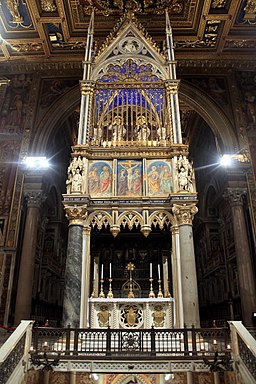The feast of the Dedication of the Lateran Basilica is of double rite and its liturgical colour is white. Today is also the twenty-fifth Sunday after Pentecost and the third Sunday of November. The Sunday is commemorated at both Vespers, Mattins, Lauds and Mass. The second Sunday of November and its week are omitted this year.
On November 9th, 324, St. Sylvester of Rome consecrated the basilica under the title of St. Saviour. This is believed to be the first public consecration of a church. The feast's title in the Breviary and Missal retains this ancient dedication: In Dedicatione Archbasilicae Ssmi Salvatoris. The texts for the Office come from the Common of the Dedication of a Church except for the lessons of the first and second nocturnes.
At Vespers yesterday afternoon the antiphons for the Octave Day of All Saints Vidi turbam magnam etc were sung, doubled, with Pss.109, 110, 111, 112 & 115. From the chapter, Vidi civitatem, the Office was of the feast. The Office was Urbs beata Jerusalem. After the collect of the feast commemorations were sung of the Octave Day of All Saints, of the Sunday (the antiphon on the Magnificat being Muro tuo for the Saturday before the third Sunday of November (with the collect from the fifth Sunday after the Epiphany) and of St. Theodore. The Suffrages were omitted as were the Dominical preces at Compline.
At Mattins the invitatory is Domum Dei decet sanctitudo, Sponsum ejus Christum adoremus in ea and the Office hymn Urbs beata Jerusalem. In the first nocturn the antiphons Tollite portas etc are sung with psalms 23, 45 & 47. The lessons are proper to the feast and are taken from the book of the Apocalypse of St. John with the responsories from the Common. These are the same as those found in the post-Clementine editions. In the second nocturn the antiphons Non est hic aliud etc are sung with psalms 83, 86 & 87, the lessons are again proper to the feast. These are almost the same as those found in later editions but lack the texts referring to Benedict XIII onwards. In the third nocturn the antiphons Qui habitat etc are sung with psalms 90, 95 & 98. The homily is from St. Ambrose on St. Luke's Gospel. The lessons are the same as those found in the later books. Today ninth lesson is of the Sunday and is a homily from St. Hiliary on St. Matthew's Gospel. These lessons are the same as in the post-Clementine editions. The Te Deum is sung.
At Lauds the antiphons Domum tuam, Domine etc are sung with the Sunday psalms (92, 99, 62-66, Benedicite & 148-149-150). The chapter is Vidi civitatem sanctam etc and the Office hymn is Angularis fundamentum (a wonderful hymn that would later be re-written as an appalling piece of pagan nonsense Alto ex Olympi vertice). After the collect of the feast commemorations are sung of the Sunday and of St. Theodore. The Suffrages are omitted.
At Prime the antiphon Domum tuam Domine is sung with the festal psalms (53, 118i, 118ii), the Dominical preces are omitted and the lectio brevis is Et absterget Deus. Quicumque and the Dominical preces are omitted. The antiphons from Lauds are sung at the other Hours with the Dominical psalms in the usual manner.
Mass is sung after Terce. The Mass formulary from the Common Terribilis est locus iste. The Gloria is sung, the second collect is of the Sunday, the third collect is of St. Theodore. The Creed is sung, the common preface is sung and the last Gospel is of the Sunday.
At Vespers the antiphons Domum tuam, Domine etc are sung with psalms 109, 110, 111, 112 & 147. The Office hymn is Urbs beata Jerusalem. The versicle and response, and the antiphon on the Magnificat are proper to second Vespers. After the collect of the feast commemorations are sung of the Sunday and then of SS Tryphon and Companions. The Suffrages are omitted as are the Dominical preces at Compline.
Image: Photograph by Wiki ktulu of the fourteenth century baldichino over the High Altar of the Lateran, Wikipedia.
Sunday, 22 November 2015
Subscribe to:
Post Comments (Atom)




No comments:
Post a Comment